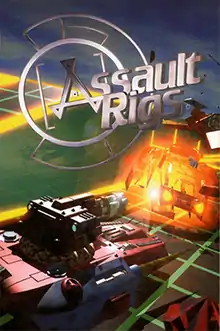Assault Rigs
Assault Rigs is an action game developed and published by Psygnosis, released in 1996 for MS-DOS and PlayStation, and a year later for the Sega Saturn in Japan. The game takes place in the future, where real sport has been overtaken in favour of virtual sport, the most popular of which is Assault Rigs, a tank simulator set inside a 3D virtual environment.
| Assault Rigs | |
|---|---|
 Cover art | |
| Developer(s) | Psygnosis (PS, MS-DOS) Perfect Entertainment (Saturn) |
| Publisher(s) | Psygnosis |
| Composer(s) | Matt Furniss |
| Platform(s) | MS-DOS, PlayStation, Sega Saturn |
| Release | PlayStationDosSaturn
|
| Genre(s) | Action |
| Mode(s) | Single-player, multiplayer |
The goal of the single player game is to collect all of the gems in a level, while destroying or avoiding enemies, ultimately reaching the exit. There are 42 levels featuring jump ramps, elevators, skyways, trenches, movable blocks and push rods. There are 20 weapon power-ups, viruses and Dolby Surround sound. The game has four themes of tanks/environment: VR, Industrial, Military and War.
Assault Rigs also has the capability to utilize the PlayStation Link Cable, enabling two players to connect two PlayStations and play head-to-head on two televisions. This setup unlocks 15 additional levels that are only available for play using the cable.
The MS-DOS version has multi-player which can be played with either a serial link (two player) or a network (up to eight players).
SoftBank planned to release the Sega Saturn version of the game in the US, along with Wipeout, Destruction Derby, and Krazy Ivan, however only Wipeout was released.[1][2][3][4]
Gameplay
Players control their rig to collect all the gems in a level and get to the end goal of each of the game's 42 levels. In the Saturn version all of the levels were the same as the PlayStation and PC versions, but they were given different names. Along the way, they can collect various types of weapons from missiles to land mines. Throughout each level, they must contend with various enemies from turrets to enemy rigs. Aerial enemies called "viruses" also attack the player's rig, while hazards such as electric gates and enemy mines dot each level. There are also mild puzzle-solving elements such as pushing blocks and building bridges.
Reception
Air Hendrix of GamePro gave the PlayStation version a mixed review. He criticized the oversensitive controls, lack of split screen multiplayer, background flicker, and inappropriate music, but praised the diverse gameplay, focus on problem-solving, and futuristic graphics, and concluded that "Noodling through Assault Rigs will be great fun for those who like a touch of thinking with their shooting."[6] Maximum gave the game credit for its "increasingly complex level designs" and the diversion of the arena levels, but asserted that "This game, while sounding quite entertaining in theory, unfortunately has a variety of problems in practice", citing poor camera angles, glitching graphics, and an overly easy and linear progression. They gave it 3 out of 5 stars.[7] Both GamePro and Maximum compared the game favorably to Cyber Sled.[6][7] Next Generation's brief review deemed the game unexciting and scored it two out of five stars.[8] Offering the game a score of 76/100, Scott Gehrs of Computer Game Review wrote, "I can't think of a better game to play when you've got some time to kill."[9]
References
- "Cover art for the Sega Saturn release of Wipeout".
- "Prototype cover art for the cancelled Sega Saturn release of Destruction Derby".
- "Prototype cover art for the cancelled Sega Saturn release of Krazy Ivan".
- "Ultra Gameplayers Volume 100" (PDF).
- "Assault Rigs". Play. No. 3. January 1996. pp. 54–55.
- "ProReview: Assault Rigs". GamePro. No. 91. IDG. April 1996. p. 70.
- "Maximum Reviews: Assault Rigs". Maximum: The Video Game Magazine. No. 3. Emap International Limited. January 1996. p. 148.
- "Every PlayStation Game Played, Reviewed, and Rated". Next Generation. No. 25. Imagine Media. January 1997. p. 57.
- Gehrs, Scott (July 1996). "Assault Rigs". Computer Game Review. Archived from the original on December 21, 1996.